AMD Radeon HD 7950 Review Feat. Sapphire & XFX: Sewing Up The High-End Market
by Ryan Smith on January 31, 2012 9:02 AM ESTCrysis: Warhead
Kicking things off as always is Crysis: Warhead. It’s no longer the toughest game in our benchmark suite, but it’s still a technically complex game that has proven to be a very consistent benchmark. Thus even 4 years since the release of the original Crysis, “but can it run Crysis?” is still an important question, and the answer continues to be “no.” While we’re closer than ever, full Enthusiast settings at a 60fps is still beyond the grasp of a single-GPU card.
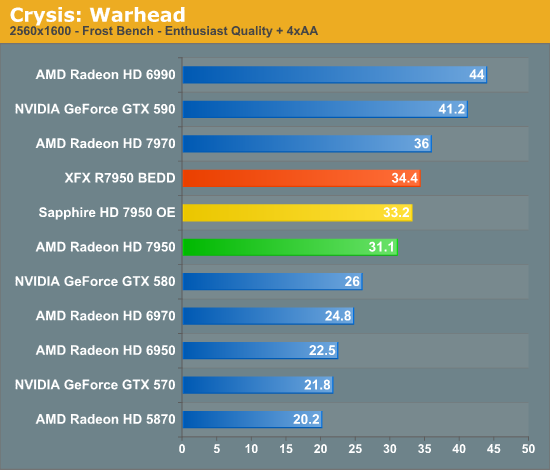
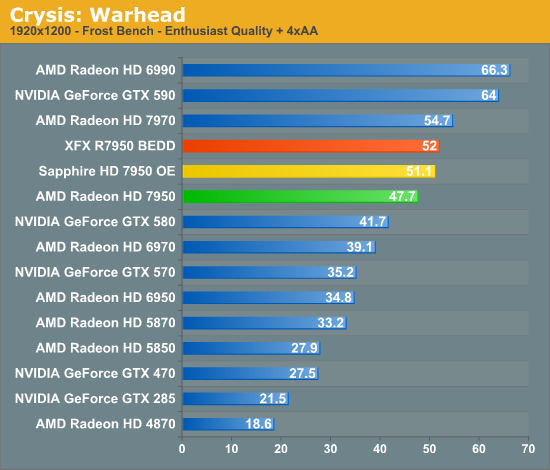
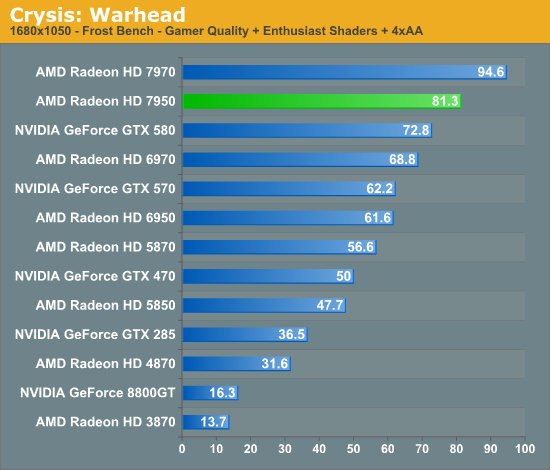
AMD’s first round of driver optimizations have given the 7900 a very solid footing in Crysis, putting the 7950 off to a great start. The 7950 is 19% ahead of the GTX 580 at 2560 and 14% ahead at 1920, putting the card in a comfortable position that for single-GPU cards is second only to the 7970. In spite of Crysis being shader-bound most of the time the 7950 is generally within 15% of the 7970, so it’s doing better than the theoretical performance gap between the two cards would predict. Meanwhile compared to AMD’s last generation offerings it’s not much of a contest: the 7950 is 20-25% ahead.
As for our factory overclocked Sapphire and XFX cards, they further close the gap between the 7950 and 7970. The 12.5% core overclock on these cards puts them between 7% and 10% faster than the stock clocked 7950, with the XFX card edging out the Sapphire due to its memory overclock. These cards do so well here than the reference 7970’s lead is reduced to just 5%.
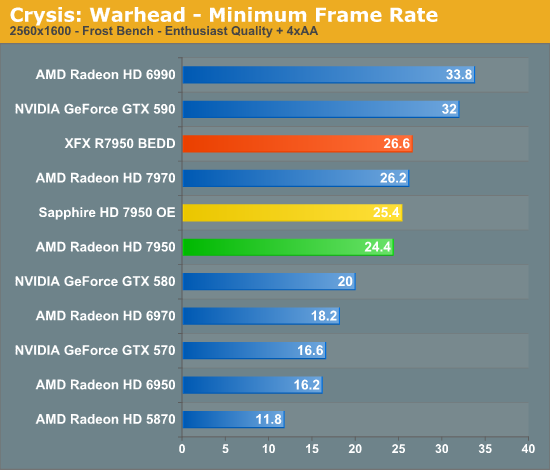

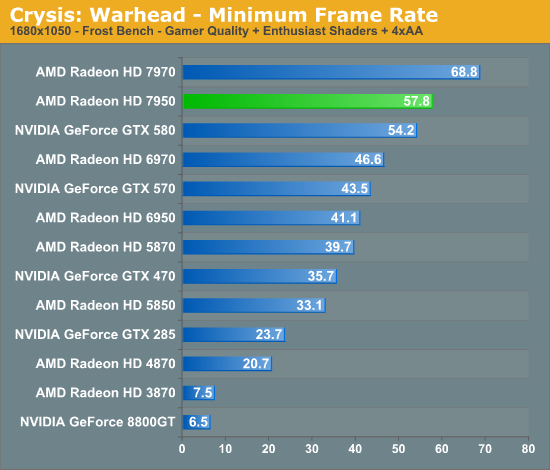
The minimum framerates in Crysis are also looking good on the 7950, with the 7950 turning in a 10-22% better minimum framerate than the GTX 580 depending on whether we’re talking about 1920 or 2560. As like we saw with the 7970, the biggest lead is at the highest resolutions, which has typically been the case for AMD cards for some time now. The overclocked partner cards add to this, tacking on an extra 5-10% in performance.










259 Comments
View All Comments
chizow - Saturday, February 4, 2012 - link
Well I'm not one to totally dismiss metrics like power consumption, thermals, noise but really those types of considerations are tertiary for anyone looking in this segment, especially when its very clear relative pricing is based on performance and performance only.Performance is primary, secondary considerations would be actual features (API, multi-mon, 3D, compute, etc.) and these fringe considerations like power, noise, heat a distant 3rd for anyone interested in this segment. It is more important for some people, but generally, performance is not the primary consideration for those people. Generally those who shop in this segment look at performance without compromise.
In any case, Nvidia's strategy for their flagship ASICs have always been big die since the G80 and from that they've generally derived their top two desktop SKUs and X2 parts. But on top of that, they also put these ASICs in their highly lucrative professional parts like Tesla and Quadro. This is not unlike Intel's strategy with their highest-end CPUs (Westmere, SB-E) where the highest-end parts are shared between their high-end server and enthusiast desktop platform.
AMD's strategy used to be "small die" after the R600 fiasco, where they would release a much smaller chip and still remain competitive through smaller process node and higher clock speeds with a halo X2 part made easier because of these smaller die sizes. But if you look at the die comparisons over the years, you can clearly see this small die strategy is getting away from them as well, as their chips have grown in size and power consumption through each generation.
There was always internal conflict over this "small die" decision though, but it looks to me like the "big die" folks are back in favor at AMD GPU as they realize they will never be able to beat Nvidia with a smaller die and higher clocks alone and aren't going to fetch a higher asking price based on just good looks and more attractive thermals.
Arnir69 - Saturday, February 4, 2012 - link
I was looking forward to 7950 but the perf jump from my 580 is negligible so I'm going to pass, was expecting more from AMD, loved their 6950 in cfx which was awesome value. If I was still running those there would be even less reason to buy 79xx. I agree with Chizow's point: Nothing new or exciting here, now looking at Kepler to shakeup 2012's high end graphics scene.chizow - Saturday, February 4, 2012 - link
Thanks, I knew there were reasonable minds out there that felt similarly. Reading through the comments there are definitely more who feel the same way, which is assuring, because I really don't want to see a $750 flagship card from Nvidia.It just seems there's a few unreasonable folks out there who just want to ignore the obvious along with mountains of historical data points that tells us what AMD has done here with Tahiti pricing is unprecedented and frankly, quite shocking.
RussianSensation - Saturday, September 8, 2012 - link
"If GK110 beats the 7970 by 20-25% and costs only $500, AMD execs will be jumping out of windows."GK104 $500 ended up losing the performance and price/performance crown to the HD7970 OC on air and on water. Looks like your prediction didn't come true this round.
HaydenOscar - Tuesday, January 31, 2012 - link
"[partner cards]"In the middle of the first page. :)
prime2515103 - Tuesday, January 31, 2012 - link
"On January 20st..."Paragraph one, line two, sentence two.
jjj - Tuesday, January 31, 2012 - link
with the 6970 starting at 300$,this one is a tough sellcasteve - Tuesday, January 31, 2012 - link
looks like a cut/paste error creeped in. :)casteve - Tuesday, January 31, 2012 - link
sapphire pricing in the table needs to be updated, too.Ryan Smith - Tuesday, January 31, 2012 - link
Please reload. It should already be fixed.